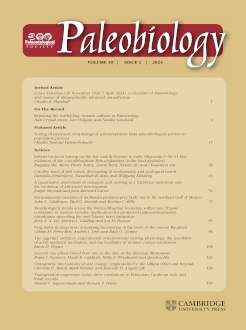Ediacaran-age sedimentary rocks (635–538.8 million years ago) contain the oldest animal fos sils that are visible to the naked eye. Several explanations have been suggested for the origins o animals in the Ediacaran, their disappearance at the end of the Ediacaran, and the followin Cambrian explosion of animals (538.8–485.4 million years ago). For this study, we examine Ediacaran–Cambrian evolutionary patterns and how fossils (data from the Paleobiolog Database) are related to the amount of sedimentary rock (data from Macrostrat) from th same time. Amounts of Cambrian rock increase to more than five times the amount o rock in the Ediacaran. The number of fossils increases in an equally dramatic manner from the Ediacaran to the Cambrian, and there are strong positive correlations between the amoun of rock and the number of fossils. It is well known that in the Cambrian, sea level rose, leadin to the flooding of the North American continent. This relative rise in sea level would hav increased the amount of rock deposited on the continent. Cambrian flooding of the continen would have also provided a wider variety of shallow-marine environments for Cambrian ani mals to expand into, providing at least a partial explanation for the dramatic increase in th number and physical diversity of Cambrian fossils. A smaller flooding event during th Ediacaran may have enabled early fossil animals to develop evolutionary traits for shallow marine environments that allowed them to rapidly evolve during the larger flooding in th Cambrian. The results of this study demonstrate that relative sea-level rise and associated con tinental-scale flooding known to influence the amount of rock may have played a role in shap ing evolutionary patterns of Earth's earliest animals.
Strata of the Ediacaran Period (635–538.8 Ma) yield the oldest known fossils of complex, macroscopic organisms in the geologic record. These “Ediacaran-type” macrofossils (known as the Ediacaran biota) first appear in mid-Ediacaran strata, experience an apparent decline through the terminal Ediacaran, and directly precede the Cambrian (538.8–485.4 Ma) radiation of animals. Existing hypotheses for the origin and demise of the Ediacaran biota include: changing oceanic redox states, biotic replacement by succeeding Cambrian-type fauna, and mass extinction driven by environmental change. Few studies frame trends in Ediacaran and Cambrian macroevolution from the perspective of the sedimentary rock record, despite well-documented Phanerozoic covariation of macroevolutionary patterns and sedimentary rock quantity. Here we present a quantitative analysis of North American Ediacaran–Cambrian rock and fossil records from Macrostrat and the Paleobiology Database. Marine sedimentary rock quantity increases nearly monotonically and by more than a factor of five from the latest Ediacaran to the late Cambrian. Ediacaran–Cambrian fossil quantities exhibit a comparable trajectory and have strong (rs > 0.8) positive correlations with marine sedimentary area and volume flux at multiple temporal resolutions. Even so, Ediacaran fossil quantities are dramatically reduced in comparison to the Cambrian when normalized by the quantity of preserved marine rock. Although aspects of these results are consistent with the expectations of a simple fossil preservation–induced sampling bias, together they suggest that transgression–regression and a large expansion of marine shelf environments coincided with the diversification of animals during a dramatic transition that is starkly evident in both the sedimentary rock and fossil records.






